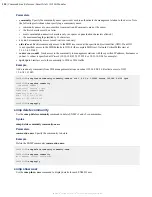
148
| Command Line Reference | SmartNA-X 1G/10G Modular
SmartNA-X
™
1G/10G User Guide 1.4
©
2015 Network Critical Solutions Limited
Version Set : v2c
sec name : public
snmp create host
Use the
snmp create host
command to configure recipients (hosts) for SNMP notifications.
If several notify directives are specified for the same host, multiple copies of each notification (in the appropriate formats)
are generated. There is a 30-second timeout for notifications. If the system is unable to reach a host during the timeout
period, it will retry up to three times in a five-minute period.
Syntax
snmp create host
HOST
{
v1
|
v2c
|
v3
} [
community
] [
Trap
|
Inform
] [
EngineID
]
Parameters
•
HOST
Specify the recipient hostname or IP address, and optionally define a transport specifier (UDP or UDP6) and a
port number. The expanded format for
HOST
is [
transport-specifier
:
]
transport-address
, where:
•
transport-specifier
is either
udp:
(default) or
upd6:
•
transport-address
[
:
port
], where
transport-address
is either a hostname or IP, and
:
port
is an optional port id.
If no transport-specifier or port is given then UDP and port 162 are assumed.
•
v1
,
v2c
,
v3
Select the SNMP version used by the host.
•
community/user
Specify the community string (SNMPv1/v2c) or user (SNMPv3).
•
Trap
,
Inform
Choose a notification format, either Traps (unacknowledged notifications) or Informs (acknowledged
notifications). If using Informs, you must set the
EngineID
of the remote host.
•
EngineID
Specify the SNMP EngineID of the host. You must specify the remote host’s EngineID if using Inform
notifications.
Examples
• Create an SNMPv3 host – assumes UDP, port 162, and Trap notifications:
CONTROLLER>
snmp create host
hostaddress
v3
user
CONTROLLER>
apply
• Create an SNMPv3 host for Inform notifications – assumes UDP and port 162:
CONTROLLER>
snmp create host
hostaddress
v3
user
remoteEngineID
CONTROLLER>
apply
• Create an SNMPv2c host – assumes Trap notifications:
CONTROLLER>
port v2c community
CONTROLLER>
apply
snmp delete host
Use the
snmp delete host
command to delete recipients (hosts) for SNMP notifications.
Syntax
snmp delete host
HOST
{
v1
|
v2c
|
v3
} [
community
] [
Trap
|
Inform
] [
EngineID
]
Parameters
•
HOST
Specify the recipient hostname or IP address, and optionally define a transport specifier (UDP or UDP6) and a
port number. The expanded format for
HOST
is [
transport-specifier
:
]
transport-address
, where:
•
transport-specifier
is either
udp:
(default) or
upd6:
•
transport-address
[
:
port
], where
transport-address
is either a hostname or IP, and
:
port
is an optional port id.






























